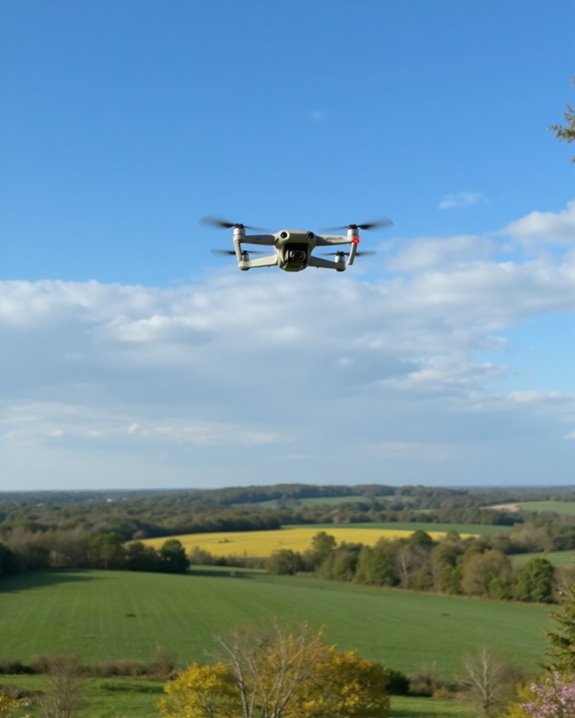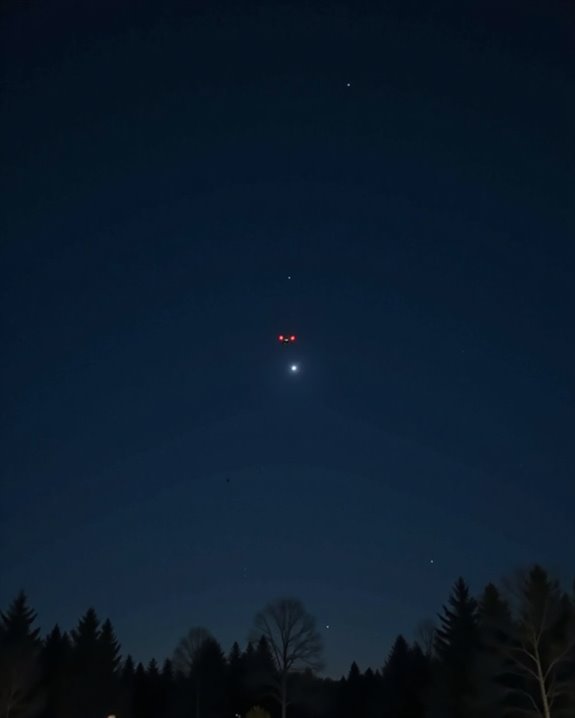No single person invented drone aircraft! The technology evolved from the Montgolfier Brothers’ unmanned balloons in 1782 to Archibald Low’s radio-controlled “aerial target” in 1917. The Sperry family’s gyrostabilizers and Edward Sorensen’s control systems moved things forward, but Abraham Karem truly revolutionized the field with his Amber prototype in the 1980s that flew for 38 continuous hours. This reliability transformed drones from quirky experiments into the essential tools we rely on today.
Key Takeaways
- The Montgolfier Brothers created early unmanned balloons in 1782, establishing fundamental flight principles used in drone development.
- Archibald Low developed the first powered drone aircraft during World War I with radio-controlled guidance systems and gyroscopes.
- The Sperry family contributed critical autopilot technology incorporating four gyroscopes that managed yaw, pitch, and roll for autonomous flight.
- Abraham Karem revolutionized drone technology with his Amber prototype achieving 38-hour continuous flight and 650 crash-free hours.
- Edward M. Sorensen developed frequency modulation technology enabling beyond-visual-line-of-sight control of unmanned aircraft.
The Montgolfier Brothers: Pioneers of Unmanned Flight
Launching humanity’s first serious venture into the skies, Joseph-Michel and Jacques-Étienne Montgolfier transformed aviation history with their groundbreaking unmanned balloon experiments in the late 18th century. Their Early Experiments began with small-scale tests before progressing to their impressive December 1782 creation—a 600 cubic foot balloon that soared nearly 600 feet before breaking free and disappearing over the horizon!
These Balloon Innovations included meticulous testing of different materials, shapes, and sizes to perfect flight stability. You can imagine the brothers’ excitement as they watched their unmanned crafts rise successfully, proving their concept worked. Their methodical approach to unmanned testing established critical safety protocols before even considering human passengers. The brothers’ paper-making expertise provided practical solutions to the technical challenges of balloon construction, making them the true ancestors of today’s remotely piloted aircraft.
Archibald Low: The True Father of Radio-Controlled Aircraft
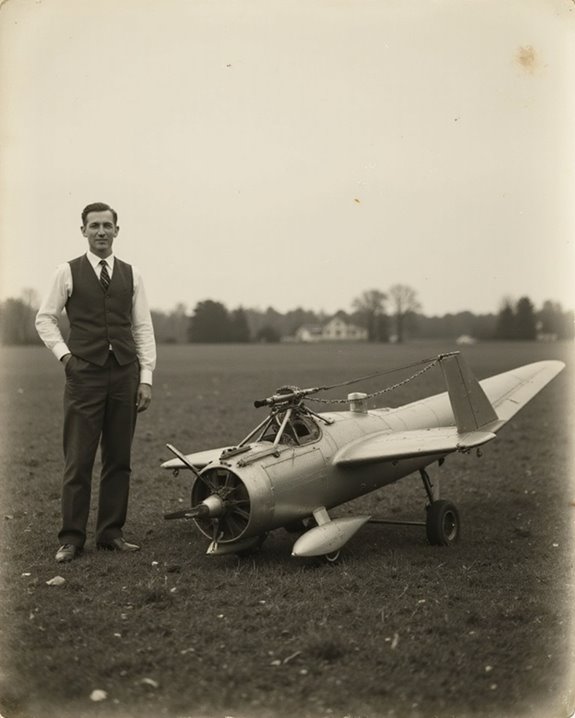
While the Montgolfier brothers pioneered unmanned balloons that floated at the whims of air currents, the true revolution in controlled unmanned flight came decades later through one remarkable inventor.
Archibald Montgomery Low, born in 1888, developed the first powered drone aircraft during World War I. As a captain in the Royal Flying Corps, he created Early Prototypes featuring radio-controlled guidance systems and even added an electrically driven gyroscope to improve stability! Despite conducting a successful test flight in 1917, many of his Rejected Ideas never saw full implementation as the British military eventually abandoned his projects.
The Germans, however, recognized Low’s genius—they twice attempted to assassinate him in 1915! Known today as the “father of radio guidance systems,” parts of his groundbreaking military drone are now preserved by the Imperial War Museum, honoring his overlooked legacy.
The Sperry Family’s Revolutionary Gyrostabilizer Technology
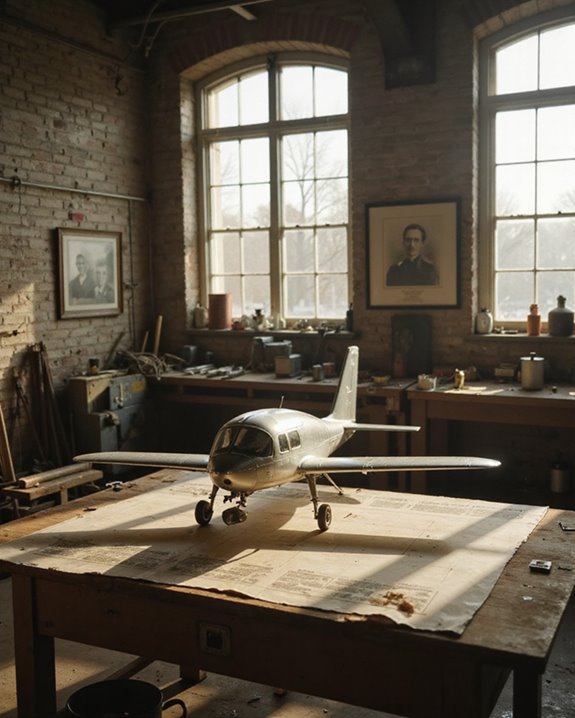
Although Archibald Low made remarkable strides in radio-controlled aircraft, it was the Sperry family who truly revolutionized flight stability with their groundbreaking gyrostabilizer technology. Elmer and Lawrence Sperry’s collaboration led to impressive Gyro Applications that transformed aviation safety forever. Their system, which incorporated four gyroscopes spinning at a dizzying 7,000 rpm, managed all three flight axes – yaw, pitch, and roll!
The Stabilizer Innovations weren’t just theoretical marvels; they demonstrated them dramatically at the 1914 Aeroplane Safety Competition in Paris. Using compressed air and mechanical linkages, their gyrostabilizers automatically adjusted control surfaces, laying the foundation for modern autopilots. The technology even found its way into military applications during World War I, including the Hewitt-Sperry Automatic Airplane. Talk about spinning into the future of flight!
Modern fixed wing drones, such as the E-flite Opterra, continue to enhance flight stability through innovations like vortex generators that improve slow-speed control and handling characteristics.
World War I: Birth of Military Drone Applications

The gyrostabilizer technology of the Sperry family soon found itself applied to an even more revolutionary concept – unmanned flight in combat zones. World War I marked the true birth of military drones, as radio-controlled aircraft were developed specifically to attack German zeppelins. These early experiments, while rudimentary, showcased the potential for WWI Reconnaissance without risking pilot lives.
What’s fascinating is how wartime innovation drove creative solutions in Drone Materials! With metal shortages plaguing production, manufacturers like Wurlitzer Musical Instrument Company turned to hardened wood components instead. These wooden wonders carried early TV cameras and radio equipment, allowing for remote targeting. Though results often disappointed military leaders, the foundation was laid for future unmanned combat aircraft that would transform warfare forever. The early drone pioneers had glimpsed the future – a battlefield where humans could stay safely behind the lines!
Reginald Denny and the Radioplane Company’s Impact
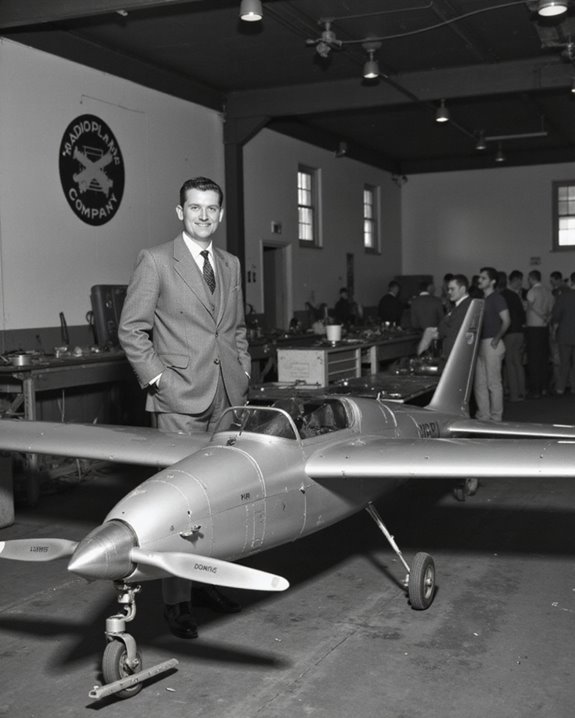
Reginald Denny, a former Royal Flying Corps pilot turned Hollywood actor, transformed his passion for model aviation into a groundbreaking military enterprise that revolutionized unmanned flight! After opening a hobby shop in the 1930s, Denny capitalized on his Engine Innovations with partner Walter Righter, whose Dennymite glow plug engines powered their increasingly sophisticated models.
The company’s RP-4 design, with its joystick controls and contra-rotating propellers, impressed military officials enough to secure vital Army contracts. During World War II, Radioplane’s OQ-2 drones became essential training tools for gunners, withstanding impressive speeds of 120 mph during testing. Talk about a high-flying success story! Denny’s Legacy Influence extends beyond military applications—he’s now celebrated as a founding father of radio control hobbies, bridging the gap between recreational flying and serious aviation technology.
Edward M. Sorensen’s Breakthrough in Remote Control Systems
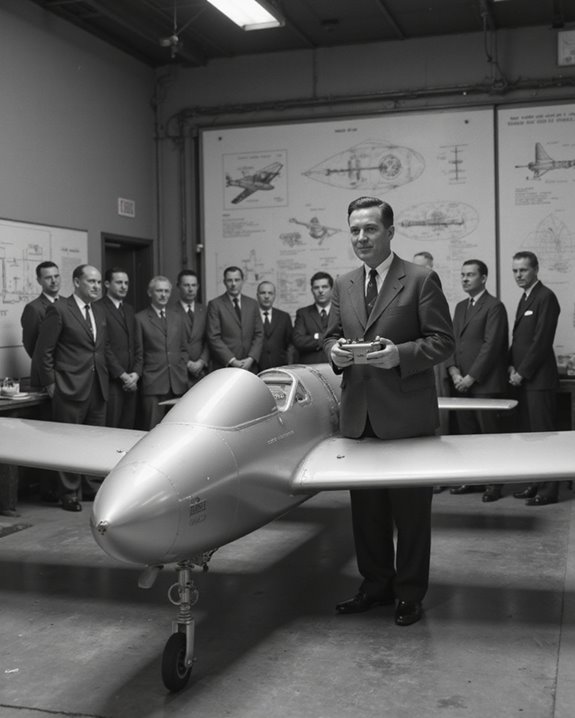
Another pioneering figure in drone aviation, Edward M. Sorensen revolutionized remote control systems with his groundbreaking 1940s patents. His genius? Creating a radio control system that enabled continuously variable operation of aircraft controls with remarkable precision!
Sorensen’s innovation employed Frequency Modulation technology to transmit clearer signals, allowing pilots to operate drones beyond visual line of sight—a true game-changer for military applications. His system tackled the persistent problem of mechanical Inertia Reduction, preventing the “hunting” or overshooting that plagued earlier designs when controls would swing past intended positions.
What made Sorensen’s contribution so valuable was how it delivered detailed feedback about the aircraft’s status—altitude, direction, engine rpm—while maintaining lightweight components critical for flight. His ground station designs influenced decades of UAV control systems, proving that sometimes, the person behind the controls deserves as much credit as the aircraft itself.
World War II: Mass Production and Military Adoption
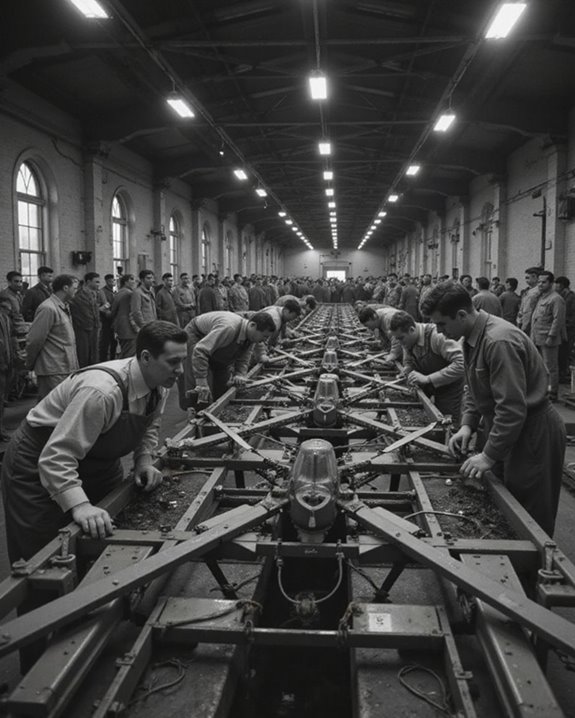
During the turbulent years of World War II, drone technology rapidly evolved from experimental curiosities to battlefield necessities, forever changing military aviation!
The Drone Evolution reached its first peak with the Radioplane OQ-2, America’s initial mass-produced UAV with over 15,000 units manufactured for target practice. Surprisingly, Hollywood actor Reginald Denny played a key role in this development! Naval Strategies expanded dramatically as the Interstate TDR-1 became an early assault drone capable of carrying bombs, while the TDN-1 made history as the first drone to launch from an aircraft carrier. Despite production challenges—only 200 TDR-1s were built from the 2,000 ordered—these innovations saw limited but meaningful combat in the Pacific Theater before being retired in 1944. The British-made Queen Bee drone, incidentally, gave us the term “drone” that we still use today!
Abraham Karem and the Modern UAV Revolution
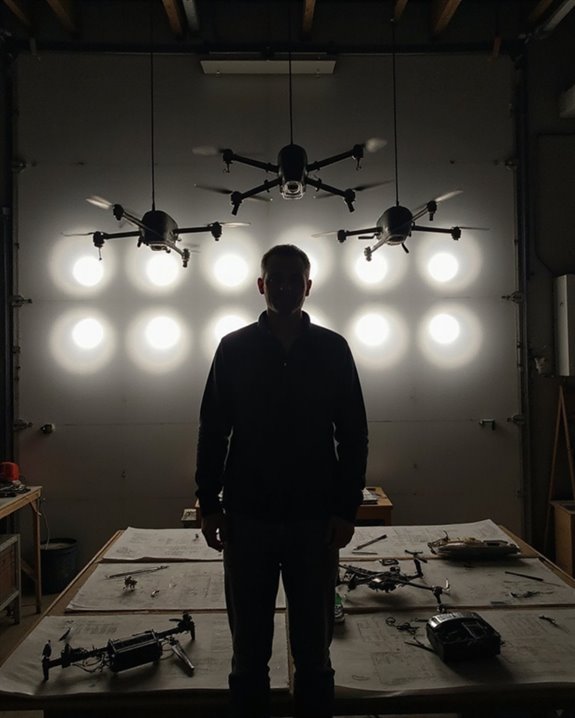
The rise of modern unmanned aerial vehicles can be traced directly to Abraham Karem, a visionary engineer whose revolutionary designs transformed unreliable experimental aircraft into dependable military assets! Born in Baghdad in 1937, this gifted Assyrian immigrant brought his talents first to Israel, then to the United States in 1977, where his Immigrant Vision would reshape aviation history.
Working from his California garage, Karem achieved an Endurance Breakthrough that stunned military experts. While contemporary drones crashed after just two hours, his Amber prototype flew for an astonishing 38 hours continuously! The reliability improvements were even more impressive – reaching 650 crash-free hours when previous systems failed regularly. Talk about a game-changer! This remarkable reliability transformed drones from quirky experiments into the essential military and commercial tools we recognize today.
From Military Tools to Civilian Technology: The Drone’s Evolution
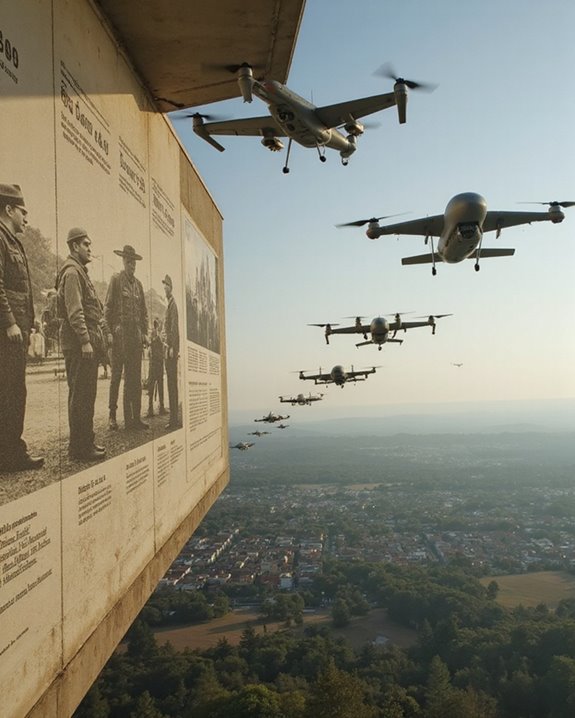
While Abraham Karem’s revolutionary designs transformed military aviation, an even broader revolution was quietly taking shape! The shift from purely military applications to widespread civilian use marked a pivotal shift in drone history. What began with the Radioplane OQ-2 in the 1940s evolved dramatically after technological advancements and cost reductions made these flying marvels accessible to everyday users.
Today’s civilian applications extend far beyond simple photography—drones now inspect infrastructure, monitor crops, and even assist in disaster response with remarkable efficiency. You’ve probably spotted them hovering at local parks or events! Future innovations focus on autonomous capabilities, with AI-powered systems and environmentally friendly electric designs leading the charge. As regulatory frameworks continue to develop, these versatile tools balance exciting possibilities with necessary privacy considerations. Many businesses are now capitalizing on this trend by offering infrastructure inspection services that provide high-value contracts to industries and government agencies.
Frequently Asked Questions
How Did Drone Battery Technology Evolve Over Time?
Drone battery technology evolved from NiMH to LiPo and finally to lithium-ion batteries, featuring significant battery chemistry advancements and capacity improvements that enabled longer flight times, reduced weight, and enhanced performance capabilities.
What Role Did Women Play in Early Drone Development?
Gentle contributors to aerial innovation, women made significant but often overlooked contributions. Hedy Lamarr’s frequency-hopping technology became foundational for drone communications, exemplifying women’s pioneering roles in developing technologies essential to modern unmanned aircraft systems.
How Were Early Drones Recovered After Flights?
Early drones employed rudimentary recovery methods including controlled crashes in open areas, parachute systems, and basic landing techniques. As technology evolved, soft-landing systems were developed, though many early models were considered expendable after flights.
When Did Autonomous Flight Capabilities First Appear in Drones?
Autonomous flight capabilities first emerged in primitive form with the Hewitt-Sperry Automatic Airplane (1917) and Kettering Bug (1918). This Autonomous Timeline of Flight Innovation began with gyroscope-based systems allowing basic preprogrammed navigation without human control.
How Did Early Drone Communication Systems Overcome Signal Interference?
Early drone communication systems overcame signal interference through dedicated frequency allocation, signal amplification, and primitive shielding techniques. Later advancements included Signal Modulation and Interference Filters to further improve transmission reliability in challenging environments.



